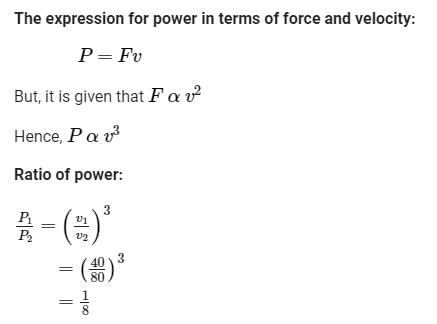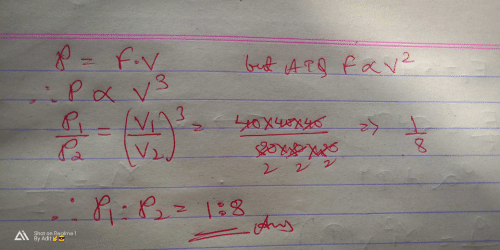NEET Exam > NEET Questions > A moving car encounters air resistance which ...
Start Learning for Free
A moving car encounters air resistance which is proportional to the square of the speed of the car. The ratio of the power required at 40 km per hour to that required at 80 km per hour, to move at constant speed. Explanation?
Verified Answer
A moving car encounters air resistance which is proportional to the sq...

 This question is part of UPSC exam. View all NEET courses
This question is part of UPSC exam. View all NEET courses
Most Upvoted Answer
A moving car encounters air resistance which is proportional to the sq...

Community Answer
A moving car encounters air resistance which is proportional to the sq...
Introduction:
When a moving car encounters air resistance, it requires power to overcome this resistance and maintain a constant speed. The magnitude of air resistance depends on the speed of the car. In this scenario, the air resistance is directly proportional to the square of the speed of the car.
Formula for air resistance:
The air resistance on the car can be represented by the equation:
Air resistance = k * v²
where v is the speed of the car and k is the constant of proportionality.
Power required:
The power required to overcome the air resistance can be calculated using the formula:
Power = Force * Velocity
Since the force is given by the air resistance, we can substitute it into the formula:
Power = Air resistance * Velocity
Comparison at 40 km/h and 80 km/h:
To compare the power required at 40 km/h and 80 km/h, we need to calculate the air resistance at each speed and then calculate the power based on that.
Calculating air resistance:
For 40 km/h:
- Convert the speed to m/s: 40 km/h = 40 * 1000 / 3600 = 11.11 m/s
- Calculate the air resistance: Air resistance = k * (11.11)²
For 80 km/h:
- Convert the speed to m/s: 80 km/h = 80 * 1000 / 3600 = 22.22 m/s
- Calculate the air resistance: Air resistance = k * (22.22)²
Calculating power:
Now, we can calculate the power required at each speed using the formula:
Power = Air resistance * Velocity
For 40 km/h:
- Power = Air resistance at 40 km/h * 11.11 m/s
For 80 km/h:
- Power = Air resistance at 80 km/h * 22.22 m/s
Ratio of power:
To find the ratio of the power required at 40 km/h to that required at 80 km/h, we divide the power at 40 km/h by the power at 80 km/h:
Ratio = (Power at 40 km/h) / (Power at 80 km/h)
Explanation:
When we calculate the ratio of the power required at 40 km/h to that required at 80 km/h, we can observe that the ratio is not 1:2.
Since the air resistance is proportional to the square of the speed, the power required to overcome the air resistance increases more than proportionally with the speed. This means that doubling the speed will require more than double the power.
In this case, the ratio of the power required at 40 km/h to that required at 80 km/h will be greater than 1:2 due to the squared relationship between air resistance and speed.
When a moving car encounters air resistance, it requires power to overcome this resistance and maintain a constant speed. The magnitude of air resistance depends on the speed of the car. In this scenario, the air resistance is directly proportional to the square of the speed of the car.
Formula for air resistance:
The air resistance on the car can be represented by the equation:
Air resistance = k * v²
where v is the speed of the car and k is the constant of proportionality.
Power required:
The power required to overcome the air resistance can be calculated using the formula:
Power = Force * Velocity
Since the force is given by the air resistance, we can substitute it into the formula:
Power = Air resistance * Velocity
Comparison at 40 km/h and 80 km/h:
To compare the power required at 40 km/h and 80 km/h, we need to calculate the air resistance at each speed and then calculate the power based on that.
Calculating air resistance:
For 40 km/h:
- Convert the speed to m/s: 40 km/h = 40 * 1000 / 3600 = 11.11 m/s
- Calculate the air resistance: Air resistance = k * (11.11)²
For 80 km/h:
- Convert the speed to m/s: 80 km/h = 80 * 1000 / 3600 = 22.22 m/s
- Calculate the air resistance: Air resistance = k * (22.22)²
Calculating power:
Now, we can calculate the power required at each speed using the formula:
Power = Air resistance * Velocity
For 40 km/h:
- Power = Air resistance at 40 km/h * 11.11 m/s
For 80 km/h:
- Power = Air resistance at 80 km/h * 22.22 m/s
Ratio of power:
To find the ratio of the power required at 40 km/h to that required at 80 km/h, we divide the power at 40 km/h by the power at 80 km/h:
Ratio = (Power at 40 km/h) / (Power at 80 km/h)
Explanation:
When we calculate the ratio of the power required at 40 km/h to that required at 80 km/h, we can observe that the ratio is not 1:2.
Since the air resistance is proportional to the square of the speed, the power required to overcome the air resistance increases more than proportionally with the speed. This means that doubling the speed will require more than double the power.
In this case, the ratio of the power required at 40 km/h to that required at 80 km/h will be greater than 1:2 due to the squared relationship between air resistance and speed.
Attention NEET Students!
To make sure you are not studying endlessly, EduRev has designed NEET study material, with Structured Courses, Videos, & Test Series. Plus get personalized analysis, doubt solving and improvement plans to achieve a great score in NEET.

|
Explore Courses for NEET exam
|

|
Similar NEET Doubts
A moving car encounters air resistance which is proportional to the square of the speed of the car. The ratio of the power required at 40 km per hour to that required at 80 km per hour, to move at constant speed. Explanation?
Question Description
A moving car encounters air resistance which is proportional to the square of the speed of the car. The ratio of the power required at 40 km per hour to that required at 80 km per hour, to move at constant speed. Explanation? for NEET 2024 is part of NEET preparation. The Question and answers have been prepared according to the NEET exam syllabus. Information about A moving car encounters air resistance which is proportional to the square of the speed of the car. The ratio of the power required at 40 km per hour to that required at 80 km per hour, to move at constant speed. Explanation? covers all topics & solutions for NEET 2024 Exam. Find important definitions, questions, meanings, examples, exercises and tests below for A moving car encounters air resistance which is proportional to the square of the speed of the car. The ratio of the power required at 40 km per hour to that required at 80 km per hour, to move at constant speed. Explanation?.
A moving car encounters air resistance which is proportional to the square of the speed of the car. The ratio of the power required at 40 km per hour to that required at 80 km per hour, to move at constant speed. Explanation? for NEET 2024 is part of NEET preparation. The Question and answers have been prepared according to the NEET exam syllabus. Information about A moving car encounters air resistance which is proportional to the square of the speed of the car. The ratio of the power required at 40 km per hour to that required at 80 km per hour, to move at constant speed. Explanation? covers all topics & solutions for NEET 2024 Exam. Find important definitions, questions, meanings, examples, exercises and tests below for A moving car encounters air resistance which is proportional to the square of the speed of the car. The ratio of the power required at 40 km per hour to that required at 80 km per hour, to move at constant speed. Explanation?.
Solutions for A moving car encounters air resistance which is proportional to the square of the speed of the car. The ratio of the power required at 40 km per hour to that required at 80 km per hour, to move at constant speed. Explanation? in English & in Hindi are available as part of our courses for NEET.
Download more important topics, notes, lectures and mock test series for NEET Exam by signing up for free.
Here you can find the meaning of A moving car encounters air resistance which is proportional to the square of the speed of the car. The ratio of the power required at 40 km per hour to that required at 80 km per hour, to move at constant speed. Explanation? defined & explained in the simplest way possible. Besides giving the explanation of
A moving car encounters air resistance which is proportional to the square of the speed of the car. The ratio of the power required at 40 km per hour to that required at 80 km per hour, to move at constant speed. Explanation?, a detailed solution for A moving car encounters air resistance which is proportional to the square of the speed of the car. The ratio of the power required at 40 km per hour to that required at 80 km per hour, to move at constant speed. Explanation? has been provided alongside types of A moving car encounters air resistance which is proportional to the square of the speed of the car. The ratio of the power required at 40 km per hour to that required at 80 km per hour, to move at constant speed. Explanation? theory, EduRev gives you an
ample number of questions to practice A moving car encounters air resistance which is proportional to the square of the speed of the car. The ratio of the power required at 40 km per hour to that required at 80 km per hour, to move at constant speed. Explanation? tests, examples and also practice NEET tests.

|
Explore Courses for NEET exam
|

|
Suggested Free Tests
Signup for Free!
Signup to see your scores go up within 7 days! Learn & Practice with 1000+ FREE Notes, Videos & Tests.

























